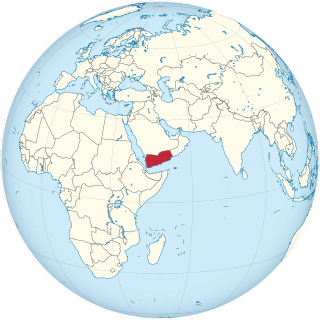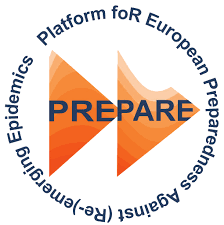Related Research Articles

A pandemic is an epidemic of an infectious disease that has spread across a large region, for instance multiple continents or worldwide, affecting a substantial number of people. A widespread endemic disease with a stable number of infected people is not a pandemic. Widespread endemic diseases with a stable number of infected people such as recurrences of seasonal influenza are generally excluded as they occur simultaneously in large regions of the globe rather than being spread worldwide.

An epidemic is the rapid spread of disease to a large number of people in a given population within a short period of time. For example, in meningococcal infections, an attack rate in excess of 15 cases per 100,000 people for two consecutive weeks is considered an epidemic.
Plague or The Plague may refer to:

Spanish flu, also known as the Great Influenza epidemic or the 1918 influenza pandemic, was an exceptionally deadly global influenza pandemic caused by the H1N1 influenza A virus. The earliest documented case was March 1918 in Kansas, United States, with further cases recorded in France, Germany and the United Kingdom in April. Two years later, nearly a third of the global population, or an estimated 500 million people, had been infected in four successive waves. Estimates of deaths range from 17.4 million to 100 million, with an accepted general range of 25–50 million, making it one of the deadliest pandemics in human history.

In epidemiology, an outbreak is a sudden increase in occurrences of a disease when cases are in excess of normal expectancy for the location or season. It may affect a small and localized group or impact upon thousands of people across an entire continent. The number of cases varies according to the disease-causing agent, and the size and type of previous and existing exposure to the agent. Outbreaks include epidemics, which term is normally only used for infectious diseases, as well as diseases with an environmental origin, such as a water or foodborne disease. They may affect a region in a country or a group of countries. Pandemics are near-global disease outbreaks when multiple countries across the world are infected.

The Hong Kong flu, also known as the 1968 flu pandemic, was a flu pandemic whose outbreak in 1968 and 1969 killed between one and four million people globally. It is among the deadliest pandemics in history, and was caused by an H3N2 strain of the influenza A virus. The virus was descended from H2N2 through antigenic shift—a genetic process in which genes from multiple subtypes are reassorted to form a new virus.

The third cholera pandemic (1846–1860) was the third major outbreak of cholera originating in India in the nineteenth century that reached far beyond its borders, which researchers at UCLA believe may have started as early as 1837 and lasted until 1863. In Russia, more than one million people died of cholera. In 1853–54, the epidemic in London claimed over 10,000 lives, and there were 23,000 deaths for all of Great Britain. This pandemic was considered to have the highest fatalities of the 19th-century epidemics.
The fourth cholera pandemic of the 19th century began in the Ganges Delta of the Bengal region and traveled with Muslim pilgrims to Mecca. In its first year, the epidemic claimed 30,000 of 90,000 pilgrims. Cholera spread throughout the Middle East and was carried to Russia, Europe, Africa and North America, in each case spreading via travelers from port cities and along inland waterways.

Seven cholera pandemics have occurred in the past 200 years, with the first pandemic originating in India in 1817. Additionally, there have been many documented cholera outbreaks, such as a 1991–1994 outbreak in South America and, more recently, the 2016–2021 Yemen cholera outbreak.
The Massachusetts smallpox epidemic or Colonial epidemic was a smallpox outbreak that hit Massachusetts in 1633. Smallpox outbreaks were not confined to 1633 however, and occurred nearly every ten years.

An outbreak of cholera began in Yemen in October 2016, and is ongoing as of August 2021. The outbreak peaked in 2017 with over 2000 reported deaths in that year alone. As of August 2021, there have been more than 2.5 million cases reported, and more than 4,000 people have died in the Yemen cholera outbreak, which the United Nations deemed the worst humanitarian crisis in the world at that time. However, the outbreak has substantially decreased by 2021, with a successful vaccination program implemented and only 5,676 suspected cases with two deaths reported between January 1 and March 6 of 2021.

Disease X is a placeholder name that was adopted by the World Health Organization (WHO) in February 2018 on their shortlist of blueprint priority diseases to represent a hypothetical, unknown pathogen that could cause a future epidemic. The WHO adopted the placeholder name to ensure that their planning was sufficiently flexible to adapt to an unknown pathogen. Director of the US National Institute of Allergy and Infectious Diseases Anthony Fauci stated that the concept of Disease X would encourage WHO projects to focus their research efforts on entire classes of viruses, instead of just individual strains, thus improving WHO capability to respond to unforeseen strains. In 2020, it was speculated, including among some of the WHO's own expert advisors, that COVID-19, caused by SARS-CoV-2 virus strain, met the requirements to be the first Disease X.

Neil Morris Ferguson is a British epidemiologist and professor of mathematical biology, who specialises in the patterns of spread of infectious disease in humans and animals. He is the director of the Jameel Institute for Disease and Emergency Analytics (J-IDEA), director of the MRC Centre for Global Infectious Disease Analysis, and head of the Department of Infectious Disease Epidemiology in the School of Public Health and Vice-Dean for Academic Development in the Faculty of Medicine, all at Imperial College London.

PREPARE is an acronym for the European Union's Platform for European Preparedness Against (Re-)emerging Epidemics. The coordinator is professor Herman Goossens of the University of Antwerp. It was activated on 31 December 2019 in response to coronavirus disease 2019 (COVID-19) and as of February 2020 was operating in outbreak response mode 2 (mobilisation), the second of three modes.
The Epidemic Diseases Act, 1897 is a law which was first enacted to tackle bubonic plague in Mumbai in former British India. The law is meant for containment of epidemics by providing special powers that are required for the implementation of containment measures to control the spread of the disease.

Michael Joseph Ryan is an Irish epidemiologist and former trauma surgeon, specialising in infectious disease and public health. He is executive director of the World Health Organization's Health Emergencies Programme, leading the team responsible for the international containment and treatment of COVID-19. Ryan has held leadership positions and has worked on various outbreak response teams in the field to eradicate the spread of diseases including bacillary dysentery, cholera, Crimean–Congo hemorrhagic fever, Ebola, Marburg virus disease, measles, meningitis, relapsing fever, Rift Valley fever, SARS, and Shigellosis.

Flattening the curve is a public health strategy to slow down the spread of the SARS-CoV-2 virus during the COVID-19 pandemic. The curve being flattened is the epidemic curve, a visual representation of the number of infected people needing health care over time. During an epidemic, a health care system can break down when the number of people infected exceeds the capability of the health care system's ability to take care of them. Flattening the curve means slowing the spread of the epidemic so that the peak number of people requiring care at a time is reduced, and the health care system does not exceed its capacity. Flattening the curve relies on mitigation techniques such as hand washing, use of face masks and social distancing.

Outbreak response or outbreak control measures are acts which attempt to minimize the spread of or effects of a disease outbreak. Outbreak response includes aspects of general disease control such as maintaining adequate hygiene, but may also include responses that extend beyond traditional healthcare settings and are unique to an outbreak, such as physical distancing, contact tracing, mapping of disease clusters, or quarantine. Some measures such as isolation are also useful in preventing an outbreak from occurring in the first place.

Jaap Tamino van Dissel is a Dutch virologist and infectiologist.